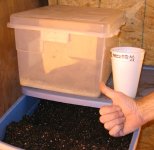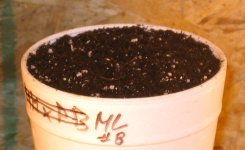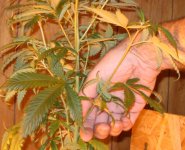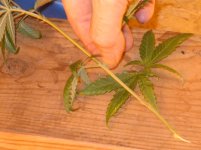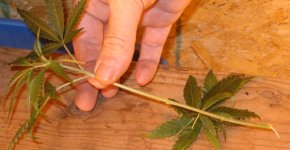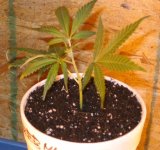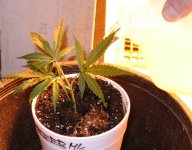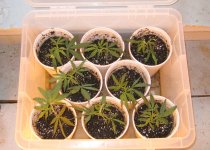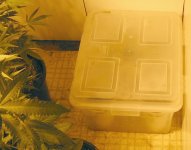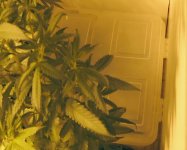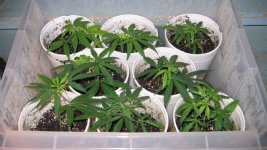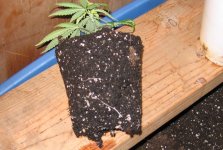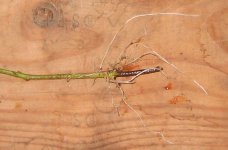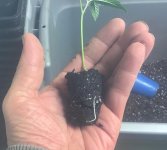Now caveman wouldn't have had the benefit of a tub fer humidity or indoor lighting, but he could use this technique to introduce species where they had not bin, or to propagate large areas with the same type of plant. Today however, folks use all kindsa contraptions & techniques to do their clonin...a lot of which are not necessary. And while this technique is no longer in wide use any more, I have shown it to prove that cloning is really very simple.
There are a lotta myths concernin how to clone:
You have to have sterile equipment. No you don't...I just did these with my dirty hands, and stuck the cutz in dirt...re-used dirt at that. Plants live in this environment, they kin handle it.
You have to use a rooting agent. No you don't...I din't use any fer this example. Plants already got the genetic code to allow them to do the rootin on their own. Rooting agents jus help things along.
You have to make the cut underwater. or
You have to soak the cuts in water. This is one of the most ridiculous things I've heard aboot clonin...the whole "air bubble in the stem" thing is simple bullshit. I din't make these cutz underwater...they weren't even cutz, more like tears...and they din't git soaked either.
You have to have a heating mat. Another "necessity" that's unneeded. Cutz will root in any temperature...well ok, not freezin temps, but you know wut I mean. They might take a lil longer if they're a bit cooler, but they will root.
...caveman wouldn't have done none of that stuff.

The plants got this thing, they already know wut to do...all you wanna do is help 'em along. In this example, my "help" has bin very minimal fer a reason...cuz I want you to see how easy this is for the plant to do. If yer not havin success in clonin, it's cuz somethin yer doin is hurtin, not helpin. Sorry to be so blunt, but let's be honest & face the music.
Now that we know it's the cut'z job to root, not ours, we kin concentrate on helpin:
Humidity - Lack of proper humidity levels is the #1 killer of rootin cutz. While it woulda bin possible fer me to do this method without the tub fer a humidity dome, I wanted to do the one thing I knew fer sure would help...keep the humidity up. Plants transpire normally, but with a cut, it has no roots from which to draw moisture from. A cut only has the stem, which is much less surface area. Keepin the humidity high, reduces the cut'z transpiration rate, so that the stem kin sustain it.
Scarification - The second most important thing you kin do to help. Plants make a generic kinda cell that kin be converted to a specific type. Certain areas have these cells normally...root tips, grow tips, nodes, etc. Scarification kin be done by makin lil gill cuts in the stem, scrappin a blade down the stem, or even scrappin with yer fingernail. Ya ain't gotta mangle it, wutz important is that you disturb the cells on the surface & damage them. This starts the plant's healin process, which happens to produce a lotta these generic cells. Those cells kin then be used by the cut to make roots.
Lighting - You can root cutz in direct lighting, but it hinders the process. When in direct light, the plant is racin with hormones instuctin it to grow. If you wanna help, then ya wanna reduce that effect. That means makin sure yer usin indirect lighting. Fluros have an opaque coating on the bulb itself, but they should still not be very close to yer rootin cutz. Other types of lighting, like HPS or MH, need an opaque dome and/or shade from other plants. The indirect lighting will allow the cut to direct more of it's resources to healin (rootin).
Rooting agent - While not required, they do help. Whether yer usin a powder, or a gel, or even honey, these agents contain anti-bacterial components and enzymes that help the "healing" process.
Medium/stem contact - Nothin kills a root tip like air...so you wanna make sure there's good contact tween the medium yer usin and the stem of the cut, cuz if a root tip starts formin on the stem and it encounters air, it will die off & scab over. In this tutorial, waterin the cutz after they were in the dirt ensured that the water would settle the dirt up against the stem effectively.
Medium saturation - Unless yer in a bubbler, ya wanna make sure not to over-saturate the medium yer usin. If yer too wet, the cut will focus on drawin in water insteada makin roots, so yer jus lookin fer moist...like cake.
These are the things you kin do to help. :)













